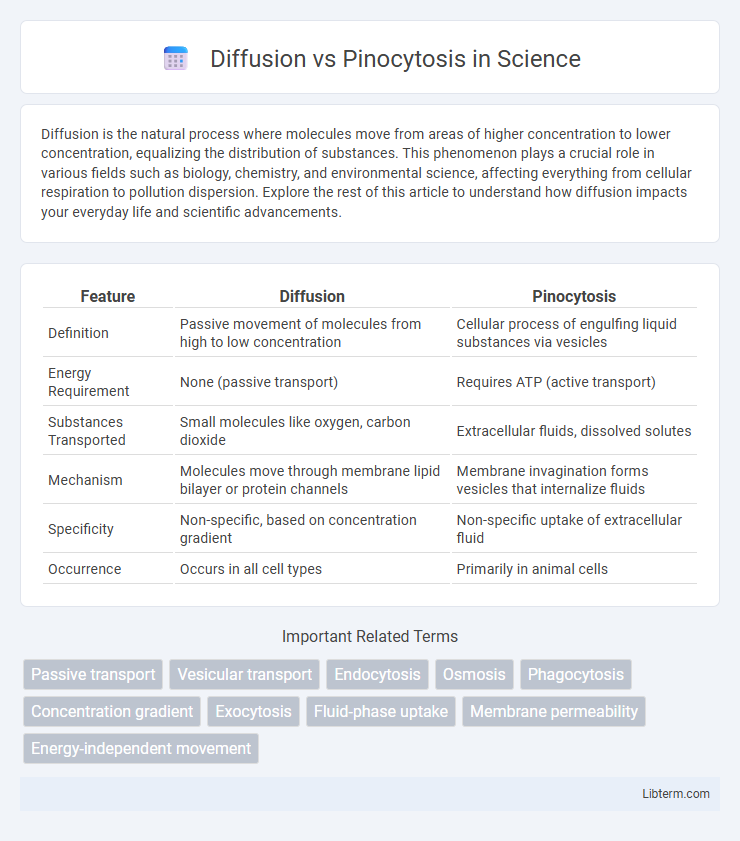Diffusion is the natural process where molecules move from areas of higher concentration to lower concentration, equalizing the distribution of substances. This phenomenon plays a crucial role in various fields such as biology, chemistry, and environmental science, affecting everything from cellular respiration to pollution dispersion. Explore the rest of this article to understand how diffusion impacts your everyday life and scientific advancements.
Table of Comparison
| Feature | Diffusion | Pinocytosis |
|---|---|---|
| Definition | Passive movement of molecules from high to low concentration | Cellular process of engulfing liquid substances via vesicles |
| Energy Requirement | None (passive transport) | Requires ATP (active transport) |
| Substances Transported | Small molecules like oxygen, carbon dioxide | Extracellular fluids, dissolved solutes |
| Mechanism | Molecules move through membrane lipid bilayer or protein channels | Membrane invagination forms vesicles that internalize fluids |
| Specificity | Non-specific, based on concentration gradient | Non-specific uptake of extracellular fluid |
| Occurrence | Occurs in all cell types | Primarily in animal cells |
Introduction to Cellular Transport Mechanisms
Diffusion is a passive transport process where molecules move from an area of higher concentration to lower concentration, facilitating the exchange of gases and small solutes across the cell membrane without energy expenditure. Pinocytosis is an active transport mechanism involving the engulfment of extracellular fluid and dissolved substances into vesicles, requiring cellular energy to internalize materials. Both processes are essential for maintaining cellular homeostasis, with diffusion enabling rapid molecule exchange and pinocytosis allowing nutrient uptake and membrane recycling.
Overview of Diffusion
Diffusion is a passive transport process where molecules move from an area of higher concentration to lower concentration, driven by their kinetic energy. This mechanism enables essential substances like oxygen and carbon dioxide to cross cell membranes without the need for energy expenditure. Unlike pinocytosis, diffusion does not involve vesicle formation or cellular engulfing of extracellular fluids.
The Process of Pinocytosis Explained
Pinocytosis is a cellular process where the cell engulfs extracellular fluid and dissolved solutes by forming small vesicles from the plasma membrane. Unlike diffusion, which involves passive movement of molecules down their concentration gradient, pinocytosis requires energy and actively transports substances into the cell. This mechanism allows cells to intake fluids and nutrients that cannot pass through the membrane by simple diffusion.
Key Differences Between Diffusion and Pinocytosis
Diffusion is a passive transport process where molecules move from an area of higher concentration to lower concentration without energy input, while pinocytosis is an active transport mechanism involving the cell engulfing extracellular fluid using energy. Diffusion occurs through the lipid bilayer or protein channels without vesicle formation, whereas pinocytosis requires vesicle formation to internalize fluids and dissolved substances. The size of transported materials in diffusion is limited to small, nonpolar molecules, whereas pinocytosis can transport larger volumes of liquid and solutes regardless of their chemical nature.
Types of Diffusion in Cells
Diffusion in cells primarily occurs through simple diffusion, facilitated diffusion, and osmosis, each enabling the passive transport of molecules across the cell membrane without energy expenditure. Simple diffusion allows small nonpolar molecules like oxygen and carbon dioxide to pass directly through the lipid bilayer, whereas facilitated diffusion uses specific carrier proteins or channels to move larger or polar molecules like glucose and ions. Osmosis is a special type of diffusion focused on the movement of water molecules through aquaporins, balancing solute concentrations inside and outside the cell.
Energy Requirements: Passive vs. Active Processes
Diffusion is a passive transport process that requires no cellular energy, relying on the natural movement of molecules down their concentration gradient. Pinocytosis is an active transport mechanism that consumes ATP to engulf extracellular fluids and solutes into vesicles. The energy dependency differentiates diffusion as a spontaneous process, while pinocytosis is energy-dependent and regulated by cellular metabolic activity.
Biological Significance of Diffusion
Diffusion plays a crucial role in maintaining cellular homeostasis by allowing the passive movement of molecules such as oxygen, carbon dioxide, and nutrients across cell membranes without energy expenditure. This process enables efficient gas exchange in respiratory systems and nutrient absorption in tissues, ensuring metabolic activities are sustained. Unlike pinocytosis, which involves energy-dependent vesicle formation to intake fluids, diffusion relies on concentration gradients to facilitate rapid and essential molecular transport in biological systems.
Functional Roles of Pinocytosis in Cells
Pinocytosis serves a critical functional role in cells by enabling the uptake of extracellular fluids and dissolved solutes through membrane invagination, supporting nutrient acquisition and cellular homeostasis. Unlike diffusion, which passively allows small molecules to move across membranes down concentration gradients, pinocytosis actively internalizes larger volumes and macromolecules essential for metabolic processes and intercellular communication. This endocytic mechanism is vital for regulating the cellular environment and responding to changes in extracellular fluid composition.
Comparative Advantages and Limitations
Diffusion efficiently transports small, nonpolar molecules across membranes without energy input, making it ideal for rapid substance exchange in cells, but it is limited by concentration gradients and membrane permeability. Pinocytosis enables cells to internalize extracellular fluids and macromolecules regardless of concentration, supporting nutrient uptake and cellular signaling, but it requires energy and is slower compared to diffusion. Both processes are essential for cellular function, with diffusion optimized for passive transport and pinocytosis offering versatility in material uptake despite higher energy demands.
Conclusion: Choosing Between Diffusion and Pinocytosis
Diffusion is ideal for passive movement of small, nonpolar molecules across cell membranes without energy expenditure, while pinocytosis actively engulfs extracellular fluids and dissolved substances through energy-dependent vesicle formation. The choice between diffusion and pinocytosis depends on the molecule size, polarity, concentration gradient, and cellular energy availability. Cells preferentially utilize diffusion for simple nutrient uptake but rely on pinocytosis for internalizing larger solutes and ensuring precise regulation of extracellular fluid composition.
Diffusion Infographic

 libterm.com
libterm.com